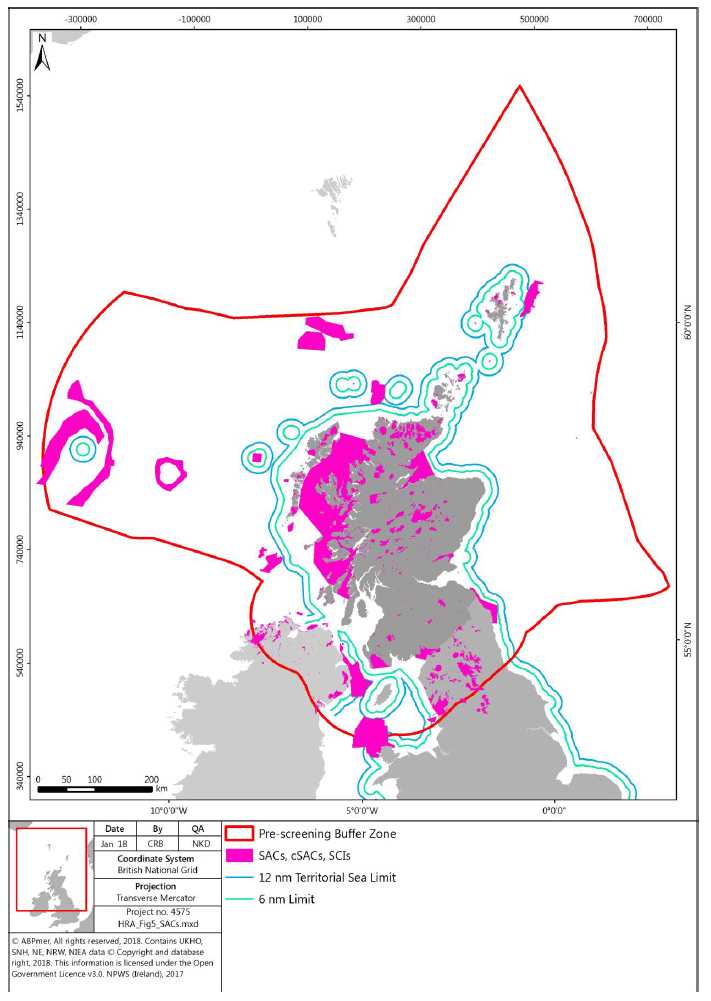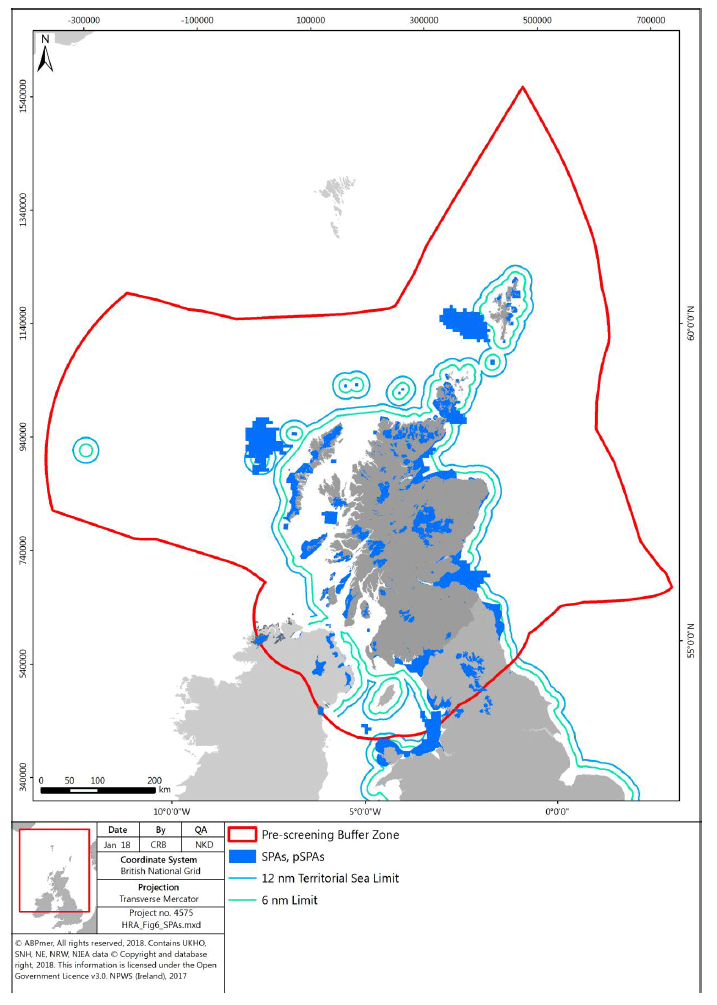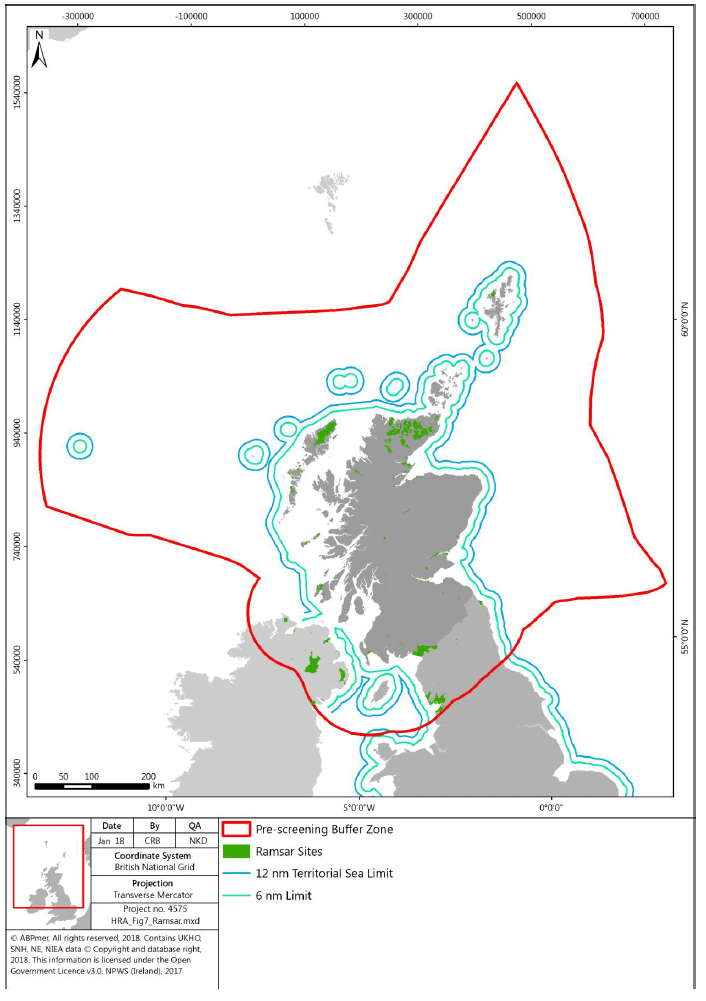Sectoral marine plan for offshore wind energy: strategic habitat regulations appraisal pre-screening report
Results of the pre-screening stages of the habitat regulations appraisal.
3 Outcomes of Pre-Screening Stages of HRA
3.1 Stage 1 - Deciding Whether the Draft Plan is Subject to HRA
3.1.1 In order to decide whether the draft Plan should be subject to HRA, it was necessary to consider the questions that are set out in Table 1.
3.1.2 Given the answers to the questions posed in Table 1 (i.e. that the draft Plan is not for conservation management and has the potential to affect one or more European/Ramsar sites), there is a requirement for an HRA. The next stages of the HRA are to identify the European/Ramsar sites that may potentially be affected, gather the information about them and ‘screen’ for the likelihood of significant effects.
Table 1: Is the Plan subject to HRA?
| Questions to Decide if HRA is Required for Plan |
Yes/No |
Outcome |
|---|---|---|
| 1. Is the whole of the Plan directly connected with and necessary to the management of a European/Ramsar site for nature conservation purposes? |
No |
Go to question 2 |
| 2. Is the Plan a ‘strategic development plan’ or ‘local development plan’ or ‘supplementary guidance’ (regulation 85A), or a core path plan (regulation 69A) or a revision thereof? |
Yes |
Proceed to identify the European/Ramsar sites that may potentially be affected, gather the information about them and ‘screen’ the plan for LSE |
| 3. Does the Plan provide a framework for deciding applications for project consents and / or does it influence decision makers on the outcome of applications for project consents? |
Yes |
|
| 4. Does the Plan contain a programme, or policies, or proposals which could affect one or more particular European/Ramsar site? |
Yes |
|
| 5. Is the Plan a general statement of policy showing only the general political will or intention of the plan-making body, and no effect on any particular European/ Ramsar site can reasonably be predicted? |
No |
Source: Adapted from Figure 4 in SNH Guidance (David Tyldesley and Associates, 2015).
3.2 Impact Pathways Resulting From Offshore Wind Development
3.2.1 As a starting point for this assessment process, the key mechanisms (i.e. the impact pathways [6] ) by which interest features can be affected by offshore wind development (including deep water wind) have been identified. These impact pathways need to encompass all stages of the development process and all potential project elements associated with the Plan. These pathways and the project activities which influence them are outlined in Tables A1 and A2 in Appendix A.
3.2.2 Table A1 presents an initial list of 18 key generic impact pathway summaries relevant to offshore wind development. This list builds on the relevant impact pathways that were identified in past HRAs (see Section 2.3), including in particular the Draft Sectoral Marine Plans for Offshore Renewable Energy (ABPmer, 2017) and the Draft Plan for Offshore Wind Energy ( OWE) (ABPmer, 2011a). The list also includes potentially significant environmental effects identified in the Environmental Statements for recent floating offshore wind farm developments, namely Hywind, Kincardine Offshore Wind Farm and Dounreay Trì Wind (Statoil, 2015; Atkins, 2016; Dounreay Trì Limited, 2016).
3.2.3 According to the methods applied in previous plan-level HRAs, the impact pathways have been separated into the standard Natura 2000 ‘categories of operations which may cause deterioration or disturbance’. These categories are derived from the list identified by the UK Marine SAC Project (2001) and are based on those applied within ‘Regulation 35’ advice documents:
- Physical Loss/Gain of habitats from removal or smothering;
- Physical Damage of habitats and species from siltation, erosion or physical injury/death;
- Non-Physical (Indirect) Disturbance from noise or visual presence and reduced availability or exclusion/displacement of species, including prey;
- Toxic Contamination from the introduction of synthetic compounds, introduction of non-synthetic contaminants;
- Non-Toxic Contamination from nutrient enrichment, organic enrichment, changes in suspended sediment and turbidity, changes in salinity or changes to the thermal regime; and
- Biological Disturbance from introduction of microbial pathogens, the introduction of invasive non-native species and translocation, or from selective extraction of selected species.
3.2.4 Each of the 18 generic impact pathways in Table A1 has been assigned a reference number that can be consistently referred to throughout the HRA documentation in order to make cross-referencing between different reports and assessments as straightforward as possible.
3.2.5 It will be important that, once a detailed understanding is available of the offshore wind devices and associated infrastructure to be deployed and the project approach to be undertaken (i.e. when individual projects are being assessed), that this plan-level impact pathway list is tailored to the individual project. On such a case-by-case basis a number of pathways may well not apply for the individual project-level assessments.
3.2.6 In Table A2, the relevant offshore wind generation activities (and the environmental changes that result from them) are presented against the relevant 18 generic impact pathways. These activities distinguish between each of the key phases of a project’s implementation (survey, construction/decommissioning and operation). Alongside, the generic activities, changes and pathways that are then presented for each project phase, the particular interest features that could be affected are also highlighted in this table. The interest features are divided into the following groups:
- Coastal, Intertidal and Subtidal Habitats and Associated Species;
- Bird Species;
- Marine Mammals (Cetaceans and Seals);
- Migratory Fish and Freshwater Pearl Mussel;
- Otters; and
- Bats.
3.2.7 The specific interest features (species and/or habitat types) comprising these groups will be considered in more detail in the following stages of the HRA process (see Section 4). This will include consideration of the differences in sensitivity of interest features to impacts from offshore wind generation activities.
3.2.8 During the subsequent assessment work these impact matrices can be especially valuable as a mechanism for reviewing the availability of mitigation measures for each of the key pathways and for each of the interest feature groups that could be affected.
3.3 Stage 2 – Identifying the European/Ramsar Sites That Should be Considered in the Appraisal
3.3.1 To progress the pre-screening review, the locations of European/Ramsar sites within and around Scotland’s Waters were mapped. To achieve this, the latest GIS mapping layers for designated and proposed European/Ramsar sites in the UK were sourced from SNH and JNCC in November 2017. Sites from the Republic of Ireland were also sourced from the National Parks and Wildlife Service ( NPWS).
3.3.2 As described in Section 2.4, the 200 nm fishery limit around Scotland and a 100 km buffer south of the Scottish border has been applied as a quantifiable and objective ‘pre-screening buffer zone’ at this initial stage of the HRA (Figure 5). A total of 652 European/Ramsar sites were identified within this buffer zone as requiring further consideration and will be taken forward into screening (Stages 5 to 7 of the HRA, see Figure 4). These sites are made up of 363 SACs, 194 SPAs, 76 Ramsar sites, 3 SCIs, 3 cSACs and 13 pSPAs and are included in Table A3 in Appendix A. Maps of these sites are shown in Figures 6 to 8 for SAC, SPA and Ramsar Sites respectively.
3.3.3 The outcome of this stage does not limit further review (in the subsequent stages of the HRA) of more distant locations or to presume that all relevant interest features, for which impact pathways exist, are necessarily affected. The methods for screening are defined in detail in Section 4.
Figure 6: Location of SACs/ cSACs/ SCIs within the pre-screening buffer zone

Figure 7: Location of SPAs/ pSPAs within the pre-screening buffer zone

Figure 8: Location of Ramsar sites within the pre-screening buffer zone

3.4 Stage 3 – Gathering Information About the European/Ramsar Sites
3.4.1 For the next stage in the pre-screening process, information on the interest features of the initially ‘screened in’ European/Ramsar sites was collated. Table A3 in Appendix A details all the interest features (including non-coastal terrestrial habitats and species) of the European/Ramsar sites present within the pre-screening buffer zone for the Plan.
3.4.2 During the subsequent screening stages of the HRA process (Stages 5 to 7 of the HRA, Figure 4), it will be necessary to determine whether the Plan will have a LSE on the initially screened in European/Ramsar sites and their interest features. Given the need for a high level of certainty to meet Habitats Regulations requirements there will be a presumption during screening and throughout the HRA process that sites and interest features listed within Table A3 in Appendix A are ‘screened into’ the assessment unless a definitive judgement of no LSE can be made, in which case they will be excluded from the process (see Section 2.6).
Contact
There is a problem
Thanks for your feedback